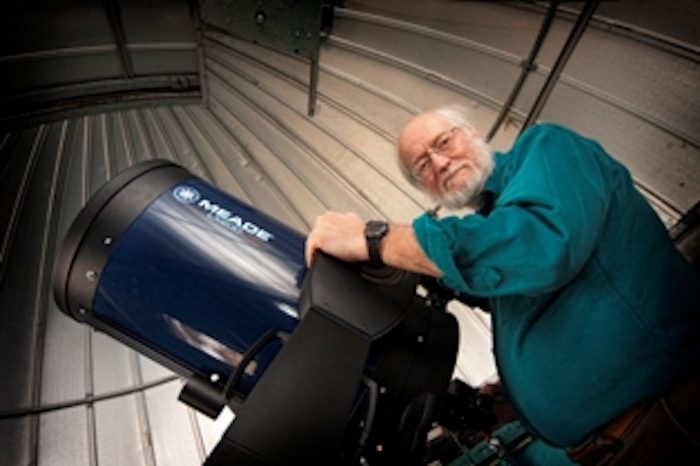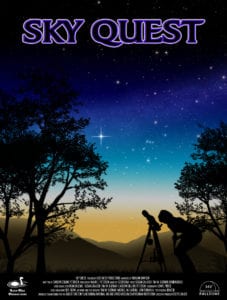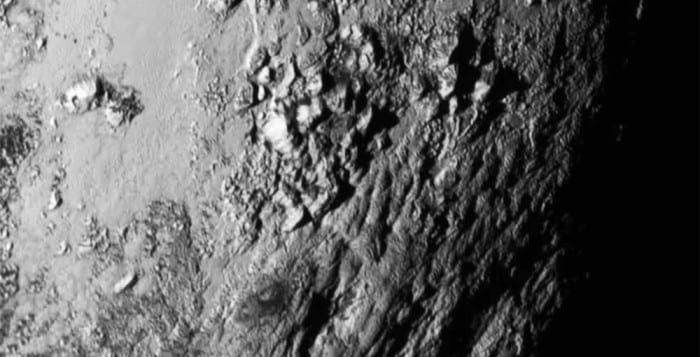By John L. Turner
As described in the article on navigating the night sky in winter (Nature Matters/November 2021), which used the constellation of Orion as a starting point, it’s equally important to have a beginning point for learning the stars and constellations of the summer sky. The best object? Without a doubt it’s the Big Dipper, which, surprisingly, is not a constellation itself (being what’s known as an asterism) but part of a larger constellation of the Big Bear or Ursa Major.
Start by learning the outline of the seven conspicuous stars that comprise the Big Dipper (four make up the bowl and three the handle). Two of the stars of the bowl — the two furthest from the handle — form the “pointer stars” which lead to finding the North Star which is the base of the handle of the Little Dipper, also an asterism.
The North Star is in a straight line about five times the distance the pointer stars are apart. Knowing the North Star will always help you if you get lost! If you move back a bit toward the Big Dipper you’ll see the four stars that comprise the bowl of the Little Dipper, if it’s sufficiently dark. The brightest of these stars, Kochab, is also known as the “Guardian of the Pole”.
If you continue on a line through the North Star but bend it slightly to the right you’ll come to a distinctive constellation that is shaped like the letter “w” or “m” or “e” or number “3” depending on the time of night. (I stayed up late to watch the Perseid meteor shower in mid-August and watched over many hours as the constellation went from a “w” to the number 3 to the letter “m”). You’ve arrived at the constellation of Cassiopeia, the Queen.
If you have a very clear sky you’ll notice that the constellation is within a fuzzy band of countless stars that make up our very own Milky Way galaxy. Astronomers tell us that our solar system is situated about halfway out on one the galaxy’s spiral arms about 26,000 light years from its center.
Speaking of galaxies you can use Cassiopeia to locate another galaxy — the nearby Andromeda Galaxy. If you visualize the constellation being oriented like the letter “w,” locate the two lower stars of the letter. The lower star to the south or to the right is a little bit lower and fairly bright. This is the star Schedar. If you drop a line about the width of Cassiopeia and a little to the right you should see a fuzzy patch. If you do, congratulations! as you’re looking at the Andromeda Galaxy — the most distant point the unaided eye can see in the universe — about 2.5 million light years away. Said another way that’s about 5.8 trillion miles away multiplied by 2.5 million. If I did the math correctly that’s 12,936,000,000,000,000,000 or 1.29 x 10(15th power) miles away or 1.29 quadrillion miles. That’s a long trip on your bicycle, no?
Going the other way — arcing from the handle of the Big Dipper “arcs you to Arcturus,” the brightest star in the constellation of Bootes the Herdsman or Hunting Farmer. Whoever saw a herdsman from this pattern of stars in which Arcturus forms the right knee must have been imbibing a bit too much as I can’t begin to make out anything resembling a person. Arcturus is spectacular, a red giant — a senior citizen among stars — with a diameter about 25X as large as our sun’s. Arcturus is Greek for “keeper or follower of the bear”, a reference to its proximity to Ursa Major, which as mentioned contains the Big Dipper.
I think Bootes looks much more like a kite or especially an ice cream cone (who doesn’t think of ice cream on summer nights, right)? with a small dollop of ice cream on top. Why a small dollop? Because much of the ice cream has fallen off the left side of the cone in the form of a small half circle of stars known as the Northern Crown or Corona Borealis. Native Americans report this constellation reminded them of a camp circle.
And what constellation in the form of a strongman lies next to this fallen scoop of ice cream? Hercules, of course, made strong from eating so much of the tasty stuff. This constellation doesn’t have any especially bright stars but, by his left shoulder, lies the Great Cluster of Hercules, which appears in ideal conditions as a milky smudge, visible with binoculars. It consists of about 100,000 stars! The cluster was discovered in 1714 by Edmond Halley, of Halley’s Comet fame. It is a mere 25,000 light years away.
If you look to the side of Hercules away from the Corona Borealis you’ll see a very bright star — Vega, in the constellation of Lyra, the Harp. Vega is the brightest star in the summer sky and forms one of the three points of the other famous summer asterism — the Summer Triangle, which forms a pretty good rendition of an isosceles triangle. Deneb in Cygnus, the Swan and Altair, in Aquila the Eagle form this highly noticeable triangle.
Let’s close by looking south. If you are in a place where you can see pretty low in the southern horizon you should be able to see two constellations that resemble their names — Sagittarius, the Archer (also known as the Teapot) and Scorpius, the Scorpion. In Sagittarius the handle of the teapot is to the left and the spout to the right. The teapot is boiling over and the stream of steam in the form of a milky band you see emanating from the spout is our Milky Way galaxy. If you view this constellation as an archer, he is shooting to the right aiming at the Scorpion.
Speaking of the Scorpion, its stinging tail is near Sagittarius and its pincers further away. The brightest star, Antares, is quite visible and appears to have a reddish hue. Like the aforementioned Arcturus it is a red giant too, making it a senior citizen among stars, nearing the end of its life. It is estimated to be 300 times larger than our sun!
While the weather is warm and comfortable, get outside and become starry eyed! There’s so much to see and behold in the heavens over your head.
A resident of Setauket, author John Turner is conservation chair of the Four Harbors Audubon Society, author of “Exploring the Other Island: A Seasonal Nature Guide to Long Island” and president of Alula Birding & Natural History Tours.





 Avalon Park & Preserve in Stony Brook will present a free screening of the documentary “Sky Quest” at its barn off Shep Jones Lane on Friday, Aug. 24 at 8 p.m. A family favorite, it tells the story of one woman’s quest for astronomy exploration and her childhood dreams of the stars.
Avalon Park & Preserve in Stony Brook will present a free screening of the documentary “Sky Quest” at its barn off Shep Jones Lane on Friday, Aug. 24 at 8 p.m. A family favorite, it tells the story of one woman’s quest for astronomy exploration and her childhood dreams of the stars.






